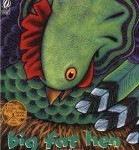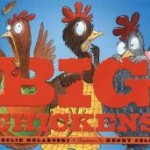Why Nursery Rhymes Work
 I had the pleasure of attending a kindergarten “family night” at an elementary school. The theme was nursery rhymes, and once again I was reminded why these rhymes are so powerful. I could (and often do) go on for days about the phonological awareness that rhyme builds, how children who are read to are exposed to thousands more words than those who hear only daily conversation and television, how we learn words best in meaningful context and how the rich language of nursery rhymes develops a child’s vocabulary, but I know I’m preaching to the choir. Instead, allow me to share with you one of my favorite nursery rhyme books, Big Fat Hen by Keith Baker. This is my go-to nursery rhyme book for littlest listeners, and all my students who are building number recognition feel like rock stars because they can read this so easily. The pictures are huge, perfect for a group share, and the text is quickly read to wiggly ones.
I had the pleasure of attending a kindergarten “family night” at an elementary school. The theme was nursery rhymes, and once again I was reminded why these rhymes are so powerful. I could (and often do) go on for days about the phonological awareness that rhyme builds, how children who are read to are exposed to thousands more words than those who hear only daily conversation and television, how we learn words best in meaningful context and how the rich language of nursery rhymes develops a child’s vocabulary, but I know I’m preaching to the choir. Instead, allow me to share with you one of my favorite nursery rhyme books, Big Fat Hen by Keith Baker. This is my go-to nursery rhyme book for littlest listeners, and all my students who are building number recognition feel like rock stars because they can read this so easily. The pictures are huge, perfect for a group share, and the text is quickly read to wiggly ones.
One of the best parts of the kindergarten family night for me was seeing how successful the students felt as they read nursery rhymes to me from books and off of posters. Because of the short, rhyming text, nursery rhymes are easily memorized, so those who are still developing word recognition and decoding skills can feel successful as they “read” from memory the rhymes. I brought a pretend candlestick (a toilet paper tube wrapped in construction paper with a red tissue paper flame which is as crafty as I get) and had students act out “Jack Be Nimble” after we read the rhyme. Amazingly fun and super-easy, make a poster of the rhyme, have 3×5 cards with your students’ names to tape up over the word “Jack”, and let your little ones be part of the rhyme.
Read MorePotty Animals!
 It’s time to potty! If you work with or have young children, you need Hope Vestergaard’s book “Potty Animals: What to Know When You’ve Gotta Go!”, illustrated by Valeria Petrone. One of the essential literacy skills kids need to become readers is “print motivation”. There has to be a reason and a desire to read, and if you give a kindergartner a book about going to the bathroom, that kid will want to read it! Not only is “Potty Animals” laugh-out-loud funny, it teaches (in rhyme) some very important life lessons like “Knock first!”, “Don’t wait too long!” and “Never forget to wipe!” This book should be read to every preschooler and kindergartner, and even a few forgetful older kids, too. After reading this book to your class, choose together the rules you want to put on a classroom poster – perfect to hang on the door if your bathroom is connected to your classroom! Potty on!
It’s time to potty! If you work with or have young children, you need Hope Vestergaard’s book “Potty Animals: What to Know When You’ve Gotta Go!”, illustrated by Valeria Petrone. One of the essential literacy skills kids need to become readers is “print motivation”. There has to be a reason and a desire to read, and if you give a kindergartner a book about going to the bathroom, that kid will want to read it! Not only is “Potty Animals” laugh-out-loud funny, it teaches (in rhyme) some very important life lessons like “Knock first!”, “Don’t wait too long!” and “Never forget to wipe!” This book should be read to every preschooler and kindergartner, and even a few forgetful older kids, too. After reading this book to your class, choose together the rules you want to put on a classroom poster – perfect to hang on the door if your bathroom is connected to your classroom! Potty on!
“One Boy”
 With cool cut-outs on the pages, One Boy by Laura Vaccaro Seeger shows how one word can be found within another word. This counting book starts with the words “One boy” (who we see through a cut-out square on the next page.) Turn the page, and the square hole is now aligned over the word “one” to show that it’s part of the word “alone”. I made index cards of each word in the word pairs where one word shows through to be part of the other word (room and brooms, etc.) After reading One Boy to kindergartners, I gave each student a card with a word and asked them to find their “word building buddy”. Even students who were still working on letter identification could hold a card next to another to see how the letter shapes matched up. Once students had found their word building buddy, we displayed the cards next to each other and asked for a class vote of thumbs up or down on whether or not a match had been made. A counting book that also helps teach print awareness? One Boy is one good book!
With cool cut-outs on the pages, One Boy by Laura Vaccaro Seeger shows how one word can be found within another word. This counting book starts with the words “One boy” (who we see through a cut-out square on the next page.) Turn the page, and the square hole is now aligned over the word “one” to show that it’s part of the word “alone”. I made index cards of each word in the word pairs where one word shows through to be part of the other word (room and brooms, etc.) After reading One Boy to kindergartners, I gave each student a card with a word and asked them to find their “word building buddy”. Even students who were still working on letter identification could hold a card next to another to see how the letter shapes matched up. Once students had found their word building buddy, we displayed the cards next to each other and asked for a class vote of thumbs up or down on whether or not a match had been made. A counting book that also helps teach print awareness? One Boy is one good book!
Big Chickens
 These chickens really are big chickens – they’re afraid of everything. When a wolf sneaks into the farmyard, they tumble out into the wide, scary world.
These chickens really are big chickens – they’re afraid of everything. When a wolf sneaks into the farmyard, they tumble out into the wide, scary world.
“‘I’m afraid to go home,’ said one chicken.
‘Ohh….’ said the others.
‘Me too.’
‘Me three.’
‘Me four.'”
But somehow, these chickens squawk, squirm, squeak, and squeal their way on some big adventures and find out that they are indeed big chickens – big, brave chickens. The language here is so rich that it’s perfect for building phonological awareness, and the art is a hoot.
After reading the book, sing with your listeners “If you’re a big chicken and you know it” and act out the scenes of the story: walk in the woods, jump in the ditch, bump into cows, etc. It’ll help your Body Smart kids to move their bodies as they retell the story, and everyone will be chiming in “Me too!” “Me three!” “Me four!”
Leslie Helakoski and Henry Cole also have Big Chickens Fly the Coop and Big Chickens Go to Town, and all three books are guaranteed to crack little ones up!
Read More








